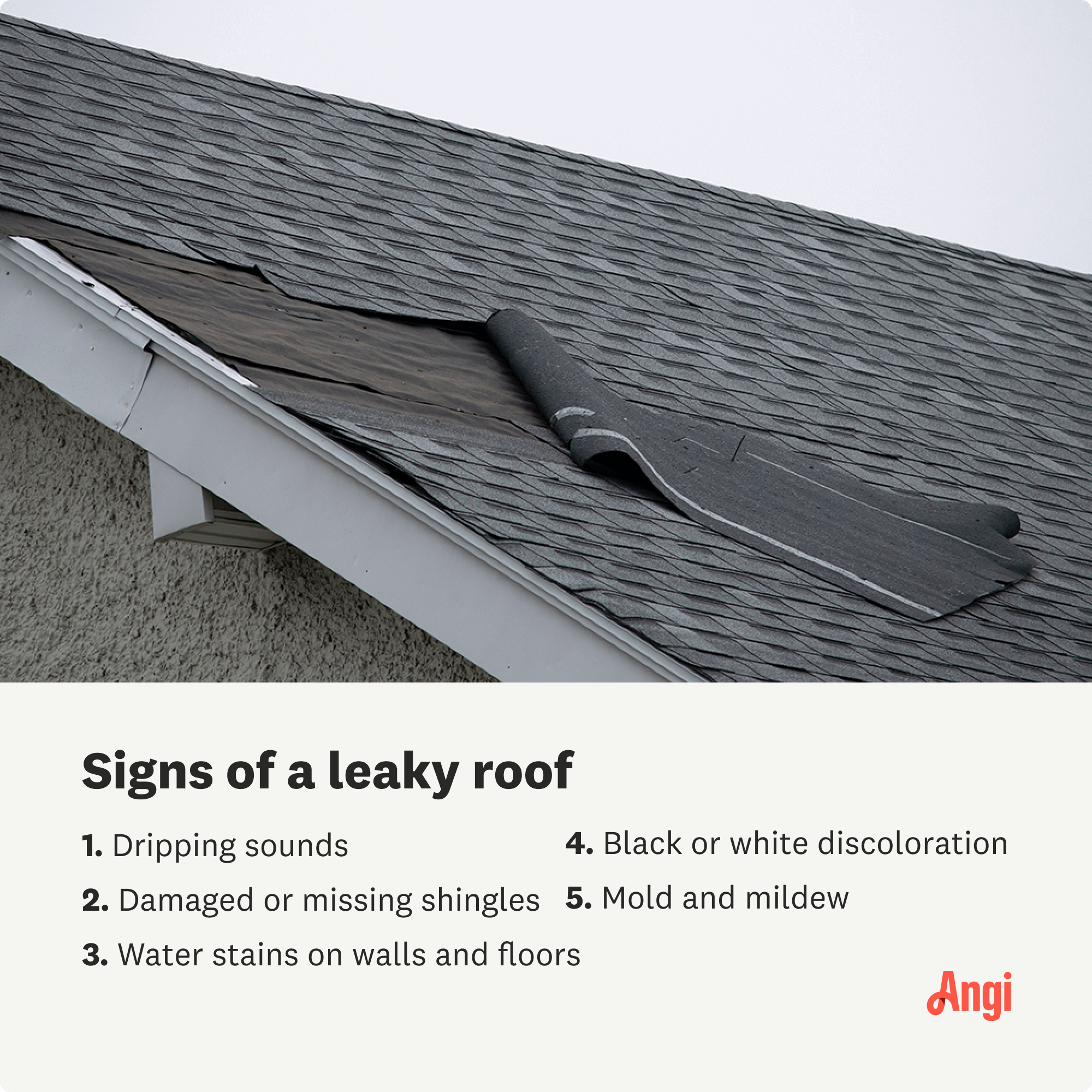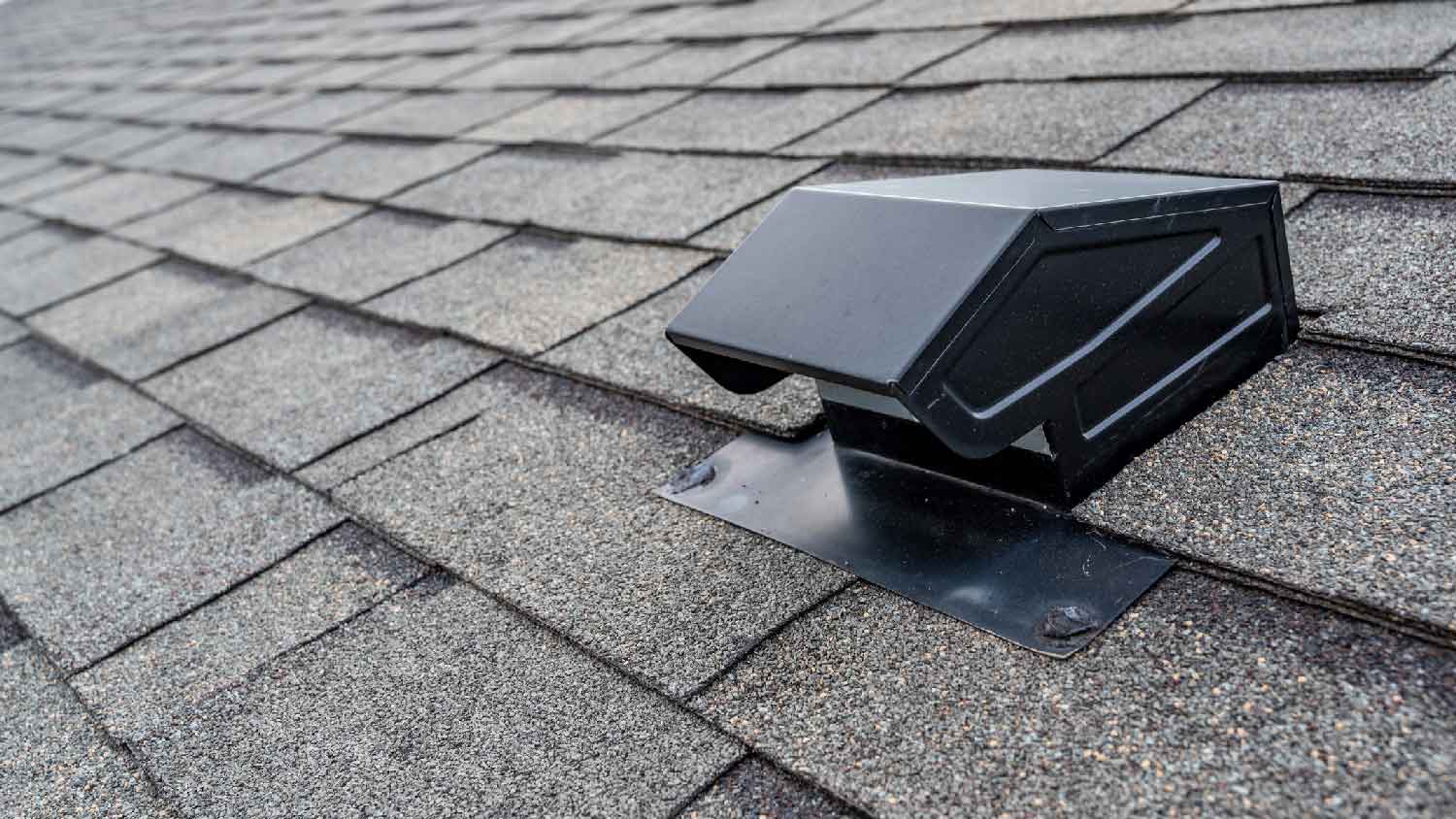
Copper is a luxury roofing material that’s highly desirable and maximizes curb appeal. Learn about copper roof costs and price factors in this guide.
A leaky roof is more than a mess—dangers lurk beneath the soggy surface


Roof leaks damage ceilings, walls, foundations, and home systems.
Damaged shingles and flashing, clogged gutters, and nails cause leaks.
You can locate leaks yourself, or call a professional for help.
When it rains, it pours, and when it pours and the roof of your home starts leaking, that is when you have a serious problem. A leaky roof can cause water to slip into the foundation of your home, where it can lead to rot, decay, and structural damage.
Whether it’s age, weather conditions, or other catastrophes, leaks in roofs are a sign that it’s time to make some repairs. Fixing that leak now could save you a ton later. Here’s what damage a roof leak could cause and how you can prevent it.
The first place water goes when your roof leaks is straight into the ceiling, and then into your attic, should your home have one. If you have an unaddressed leak in your roof, you can expect water to damage the contents of your attic and also to darken, stain, and damage the ceiling. Water damage restoration costs for ceiling repairs typically start at $350 and can go up to $2,000, depending on the severity of the leak.
As water leaks into your home, starting at the roof and then leaking into the attic, it can seriously damage any insulation you may have inside your roof. The water causes the insulation to clump, making it virtually ineffective at keeping warm or cool air inside your home, depending on the season. Be sure to regularly inspect your roof so you can stop damage before it escalates.
A leak in your roof can inevitably lead to a serious mold or mildew problem. That mold and mildew does not just indicate where the water has gone, either. Mold spores in water-damaged homes can pass through HVAC systems, leading to serious illness for people with allergies, asthma, environmental sensitivities, and compromised immune systems.
Drywall is commonly used to divide spaces within the home during the construction phase of the process. You should not expose drywall to water, but when you have a leaky roof, that is exactly what happens. Too much water can cause your drywall to sag, buckle, or fall apart.
"Get a roof inspection done by a professional if you see cracked or missing tile, lifted/curling shingles, degranulation of shingles, or weeds/plants growing on the roof,” says Ryan Westfall, vice president of Westfall Roofing in Tampa, Florida.
Water and electricity do not mix. When you realize there is a leak in your home and you know that your attic contains wiring, make sure that a local professional electrician examines the damage. This precaution keeps you safe from shocks and your home safe from any potential errant sparks flying that could cause a fire.
A roof leak near electrical wiring is a serious safety concern because water can come into contact with exposed wires, potentially causing electrical short circuits, sparking, and fire hazards. If you suspect a leak near wiring, immediately turn off the power to the area and call a roofer and an electrician to handle the issue.
We already mentioned the effect that water damage has on insulation, but damaged installation caused by a leaky roof can also lead to another problem: energy inefficiency. If your insulation is not doing its job, you will wind up using more power and losing more money. This is bad for the environment and bad for your wallet.
Even the strongest homes are susceptible to the rot that comes with water damage. What starts as a small leak in your roof can develop into a systemic failure of your home’s foundation. All that water can leak down to your foundation levels and start rotting, making it unstable. Stop leaks in their tracks before they become even bigger problems.
The following areas are those most likely to be structurally damaged by roof water damage:
Rafters and ceiling joists
Wall framing
Fascia boards
Exterior trim
Floors
Roof leaks are unfortunately common, often caused by the following:
Roofing nails that shift, come loose, or back out of their holes
Clogged or damaged gutters, and clogged downspouts
Cracked, broken, damaged, or missing shingles
Roof shingles that are buckling, curling, or losing granulation
Cracked, displaced, or missing flashing
Roof valleys that have been sealed incorrectly or with deteriorating sealant
Cracks in and around chimneys
Cracks, gaps, and failure of pipe boots and vent collars
Aging, deteriorating, or improperly installed skylights
Ice dams
Hail damage
Damage from fallen tree branches
When damage to a roof or its components creates a hole, crack, or weak spot, water can get in during rainy weather. Roof problems are also common in winter, due to the change in temperature and harsher climate.
It is important to have regular roof inspections and perform maintenance or repairs any time there is a chance your roof has been damaged. Look for signs of a roof leak like water stains or musty smells. Most leaks start out as small defects, but they can easily grow if left unrepaired for even a short time. And while roof repairs will cost you something, they are cheaper than roof replacement costs.
The most commonly sought-after asphalt shingle roof repair involves fixing water leaks. Homeowners also want recommendations from a roofer for repairs that prevent damage and keep their roofs in good condition. Other issues include broken, missing, cracked, and loose shingles, water stains, and other related problems.

So, you’ve spotted a leak in your roof—what now? What’s crucial is that you don’t ignore it. Even a small leak can lead to bigger issues if left unchecked. Here’s what to do:
Contain the Water: Place a bucket or container under the leak to protect your floors. Use towels to keep it from soaking through.
Find the Source: Leaks don’t always show up right below the damaged part of the roof. Take a flashlight and check your attic or ceiling for signs of moisture, water stains, and damaged insulation.
Check Gutters and Downspouts: If there’s a clog or damage in the gutters or downspouts, this could cause water not to drain properly and flood your roof. Clear away any debris or hire local gutter cleaning to make sure water can flow freely off the roof.
Check Shingles: Take a close look at shingles, tiles, or other roofing material. Missing, cracked, or curling shingles can be a sign of roof damage that needs repair.
Document the Damage: Take photos of the leak and any visible damage. This could come in handy if you need to file an insurance claim.
Call in a Pro: If the leak is small and you’re good with some basic tools, you might be able to patch the roof damage yourself temporarily. But for bigger leaks or if you’re unsure of the extent of the damage, it’s always best to call a local roof sealing pro. They have the right tools and experience to properly fix your leaky roof.
From average costs to expert advice, get all the answers you need to get your job done.

Copper is a luxury roofing material that’s highly desirable and maximizes curb appeal. Learn about copper roof costs and price factors in this guide.

If your metal roof needs a repair, it’s best to hire a roofing professional to handle it safely. Stay tuned to learn about cost factors for metal roof repair.

Learn all of the factors you need to consider to estimate roof ridge cap replacement costs, whether it’s safe and worthwhile to DIY the work, and more.

Roof sheathing is another name for the strong layer of wood boards that are attached to your roof’s framing. Learn how much roof sheathing costs in this guide.

Roof sealant helps protect your roof from the elements. Learn about different types of roof sealant and how to pick the right one for your roof.

This guide lays out the cost to install a roof vent on your home depending on the type of ventilation that's best for your roof based on several factors.